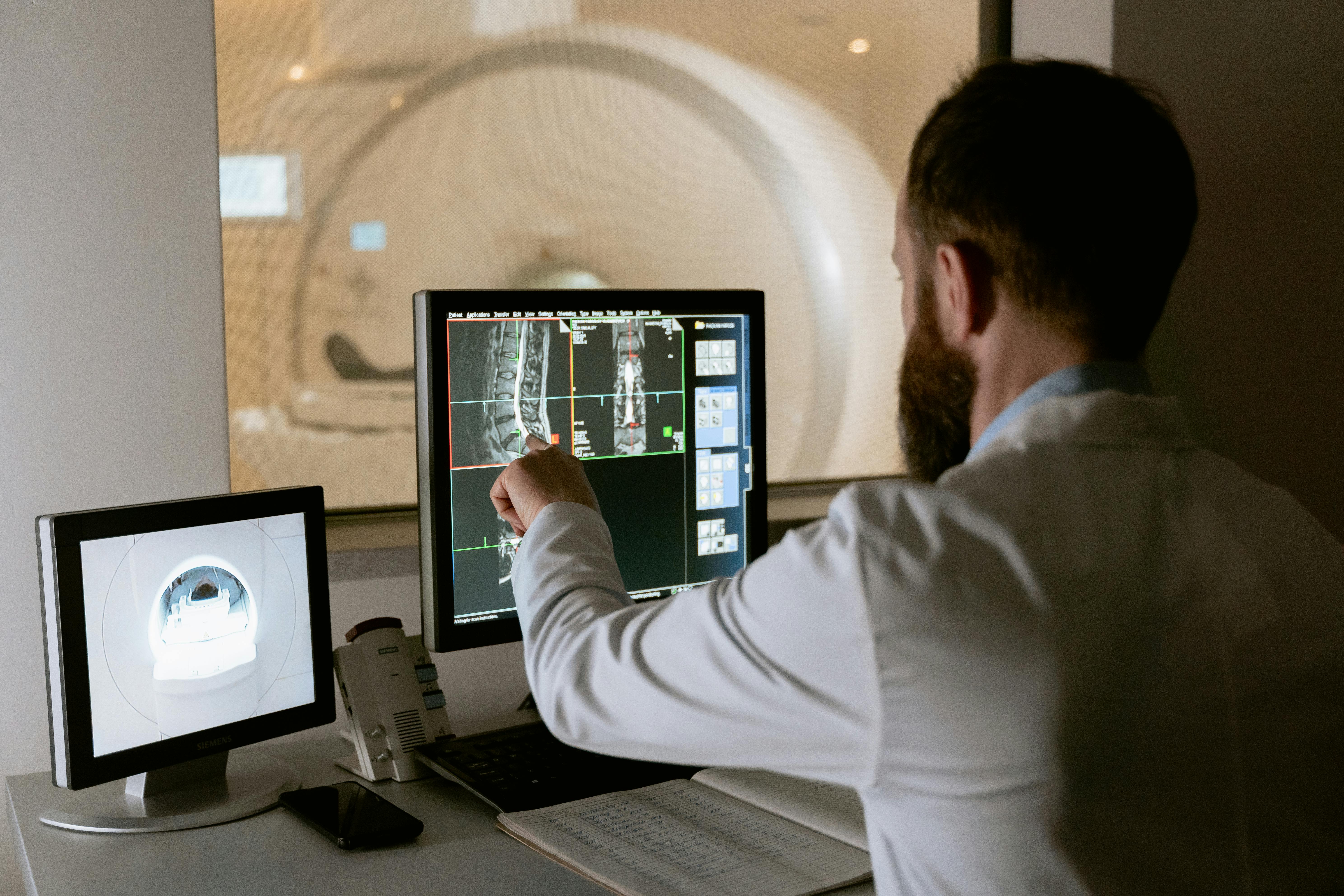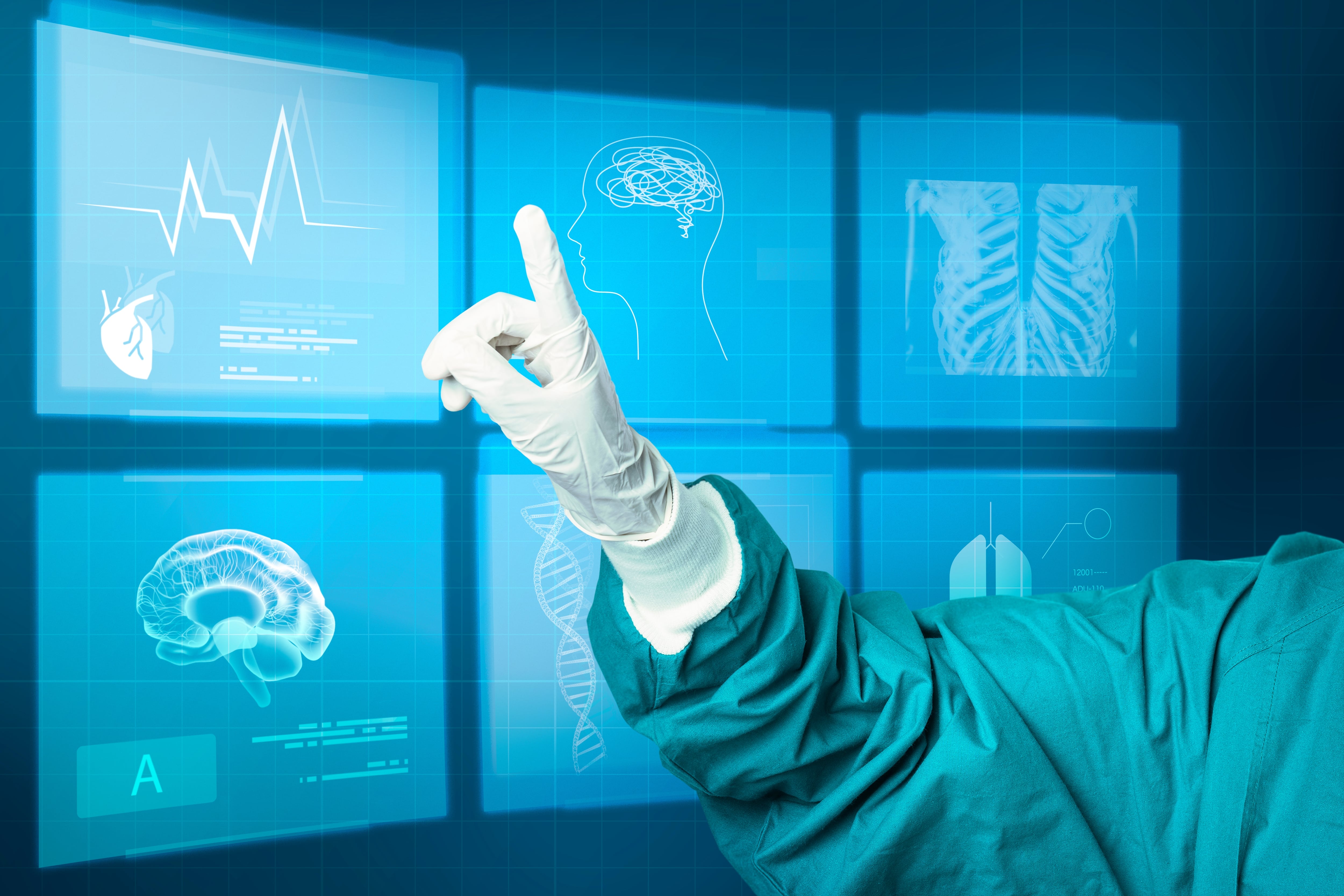Explore 20 ai healthcare companies leading patient access, imaging, and RCM in 2025—use cases, outcomes, and how to choose the right partner. Get insights.

Artificial intelligence is no longer a futuristic concept in medicine; it’s a present day reality. From the front desk to the operating room, AI is transforming how healthcare is delivered. It’s helping to streamline tedious administrative tasks, enhance diagnostic accuracy, and personalize patient treatment plans. If you’ve ever wondered how this technology works in a real clinical setting, you’ve come to the right place.
This guide explores 22 practical examples of AI in hospitals, showcasing how algorithms and machine learning are becoming indispensable tools for clinicians and administrators alike.
Before a doctor ever sees a patient, a mountain of administrative work has to be done, especially in health systems with large call volumes. This is where some of the most impactful examples of AI in hospitals are found, working behind the scenes to make operations smoother, reduce staff burnout, and improve the patient experience.
An internal chatbot is a conversational AI used by hospital staff to get instant answers. Instead of calling a busy help desk for IT issues or HR questions, employees can ask a bot. During the COVID 19 pandemic, Mass General Brigham launched a chatbot for its 80,000 employees to clarify complex return to work policies. In its first five weeks, over 5,500 employees got answers in about 1.3 minutes on average, and the tool helped slash the median daily call volume to the Occupational Health hotline from 633 to just 115.
Patient facing chatbots act as virtual assistants on hospital websites or patient portals, available 24/7. For specialty group practices, they can answer prep questions and handle scheduling tasks so staff can focus on in‑office patients. They can answer common questions about appointment preparation, billing, or clinic hours, freeing up human staff for more complex issues. Now, similar technology is expanding beyond the web and into phone systems through AI voice agents. These tools handle the same front-desk workflows — from scheduling and rescheduling to verifying insurance or directing calls — but through natural, conversational speech. Prosper AI, for example, builds healthcare-specific voice agents that automate phone-based tasks like appointment booking, benefits verification, and prior authorization, helping practices cut hold times and reduce staff burnout while maintaining a warm, human experience.
Missed appointments cost the U.S. healthcare system an estimated $150 billion annually. AI models analyze patient history, appointment type, wait time, and other factors to predict the likelihood of a no show. With this insight, clinics can send extra reminders to high risk patients or strategically double book slots. This proactive approach is one of the most effective financial examples of AI in hospitals. For instance, AI voice agent platforms like Prosper AI can automate reminder calls and make it easy for patients to confirm or reschedule, helping clinics reduce their no show rates by around 30%.
Up to 30% of 911 ambulance calls are for low acuity issues that don’t truly require an emergency department (ED). AI can help dispatchers identify these calls in real time. For example, the AI platform Corti listens in on emergency calls and can detect signs of critical illness like cardiac arrest from the caller’s breathing patterns, often faster than human dispatchers. Conversely, it can also flag non urgent calls, allowing them to be diverted to a nurse advice line or an urgent care center, which keeps emergency resources free for true life threatening situations.
ED crowding can lead to long wait times and worse patient outcomes. AI models use historical data, weather patterns, and local events to forecast how many patients will need an emergency or inpatient bed. One hospital using an AI forecaster reduced average ED waiting times by 10 to 20% by adjusting staffing based on predicted patient volume. This helps hospitals prepare for surges, ensuring they have the right staff and resources available when patients need them most.
The burden of paperwork and the risk of human error are two major challenges in healthcare. AI is providing a powerful second set of eyes, helping to reduce mistakes and free clinicians from their keyboards.
Physicians in the U.S. spend an average of 15.5 hours per week on paperwork. Ambient AI tools are changing this by listening to doctor patient conversations and automatically generating clinical notes. A study with the Suki digital assistant found that family doctors reduced their documentation time by 72%, saving an average of 3.3 hours per week. This technology not only fights clinician burnout but also allows doctors to focus more on their patients instead of their screens.
Simple documentation mistakes can have serious consequences. Shockingly, studies indicate up to 70% of medical records contain at least one error. AI algorithms can scan clinical notes and medication orders to spot inconsistencies, such as a note mentioning a drug allergy that isn’t flagged in the prescription system. One hospital that implemented an AI documentation tool reduced medication documentation errors by 45% by having the system flag unusual dosages for pharmacist review.
Accurate medical coding is crucial for billing and reimbursement. AI tools audit clinical documentation to ensure all diagnoses and procedures are coded correctly. They can identify missed complications or comorbidities that, when documented, lead to a more appropriate Diagnosis Related Group (DRG) and better reimbursement. This also reduces claim denials; one facility saw a 35% reduction in denials after implementing an AI documentation review. This is one of the clearest examples of AI in hospitals improving both compliance and revenue integrity.
Some of the most exciting examples of AI in hospitals are in diagnostics, where machine learning models are trained to see, hear, and detect patterns that can elude human senses, leading to earlier and more accurate diagnoses.
A cough can be a valuable clinical clue, but it’s rarely measured objectively. AI powered smartphone apps can now record and analyze the sound of a cough to help screen for diseases. An MIT led team trained a model that could identify COVID 19 positive coughs with 98.5% accuracy, even in asymptomatic individuals. Other algorithms are being used to screen for tuberculosis and track cough frequency over time to monitor treatment effectiveness.
Between 20% and 50% of hospitalized patients suffer from malnutrition, but it often goes undiagnosed. AI can scan a patient’s electronic health record for subtle indicators like unintentional weight loss, low albumin levels, or notes about poor appetite. By flagging at risk patients early, clinicians can intervene with nutritional support, which is proven to shorten hospital stays and reduce complication rates.
Many rare genetic disorders cause subtle but distinct facial features. AI platforms like Face2Gene use deep learning to analyze a patient’s photograph and suggest possible syndromes. In one study, an AI model called DeepGestalt placed the correct syndrome in its top 10 suggestions 91% of the time, outperforming clinical experts and helping to shorten the diagnostic journey for families.
An estimated 20 to 30% of advanced imaging tests may be unnecessary. AI driven decision support tools help clinicians choose the most appropriate test (X ray, CT, MRI, etc.) based on the patient’s symptoms and medical guidelines. These systems are integrated into the ordering process (often via integrations with the EHR) and can significantly reduce low value scans, saving costs and sparing patients from unnecessary radiation exposure.
Early detection is key to surviving oral cancer. AI models trained on thousands of photos of mouth lesions can distinguish between benign sores and potentially cancerous spots with high accuracy. In community screening programs, health workers can use a smartphone app to take a photo, and the AI provides an immediate risk assessment, helping to fast track high risk patients for a biopsy.
The smart stethoscope is a classic medical tool supercharged with AI. Devices from companies like Eko can record heart sounds and ECG signals, which an algorithm then analyzes for signs of heart failure, such as a weak heart pump (low ejection fraction). An AI algorithm developed with the Mayo Clinic demonstrated the ability to detect low ejection fraction from a 15 second ECG with high accuracy, potentially bringing screening for this silent condition into routine physical exams.
When a patient arrives at the ER with chest pain, every second counts. AI can analyze a patient’s initial ECG and clinical data to quickly identify those likely having a heart attack. One AI model was able to improve the detection of subtle heart attacks on an EKG by 37% compared to human readers. This allows the care team to activate the cardiac cath lab sooner, because in a heart attack, time is muscle.
Lung nodules are found on millions of CT scans each year, and while most are benign, some are early lung cancers. AI algorithms analyze the size, shape, and texture of these nodules to assess their cancer risk. A Google AI model was able to detect 5% more cancers and had 11% fewer false positives compared to a panel of six radiologists, showcasing how AI can serve as a powerful second opinion.
Beyond diagnosis, AI is helping to predict how diseases will progress and which treatments will be most effective, paving the way for a new era of personalized medicine. These predictive models are some of the most advanced examples of AI in hospitals today.
Preventing avoidable hospital readmissions is a major goal for health systems. AI models analyze patient data to identify individuals at high risk of being readmitted soon after discharge. This allows hospitals to target interventions, like follow up calls or home health visits, for the patients who need them most. Since nearly 20% of Medicare patients are readmitted within 30 days, better prediction can lead to significant cost savings and better patient outcomes.
Also known as a “robot anesthesiologist,” a closed loop AI system can monitor a patient’s vital signs and brain activity during surgery and automatically adjust the dose of anesthetic drugs in real time. These systems can maintain the desired depth of anesthesia with incredible precision, often more consistently than manual control. This allows the human anesthesiologist to focus on the bigger picture, ensuring overall patient stability during complex procedures.
For chronic eye diseases like macular degeneration or glaucoma, knowing who will progress quickly is critical. AI models can analyze retinal scans and predict the likelihood of vision loss over time. This helps ophthalmologists personalize follow up schedules and treatment plans, intervening earlier for high risk patients while avoiding over treatment for those whose condition is stable.
Ulcerative colitis is a chronic disease with periods of remission and painful flares. By analyzing patient reported symptoms and biomarkers like fecal calprotectin, AI models can predict an impending flare up to two weeks in advance with around 80% accuracy. This early warning gives patients and doctors a chance to adjust medication and potentially prevent the flare or reduce its severity.
AI can analyze a patient’s health data to generate a personalized risk score for surgical complications. A model at one hospital predicted major complications with significantly higher accuracy than traditional risk calculators. This information helps surgeons and patients make more informed decisions and allows the care team to implement “prehabilitation” strategies, like improving nutrition or fitness before surgery to lower risk.
The same cancer can respond very differently to treatment from one person to the next. AI is being used to analyze a tumor’s genetic makeup and predict which chemotherapy or targeted therapy is most likely to work. This helps oncologists select the best treatment first, sparing patients from the trial and error of ineffective therapies and their side effects.
The landscape of healthcare is being reshaped by these powerful technologies. By taking over repetitive tasks and providing data driven insights, AI is empowering healthcare professionals to deliver more efficient, accurate, and personalized care. To see how AI can start automating administrative workflows in your own practice, explore solutions from Prosper AI. Ready to pilot? Get started.
1. What are the main benefits of using AI in hospitals?
The primary benefits include increased operational efficiency, reduced administrative burden and staff burnout, enhanced diagnostic accuracy, fewer medical errors, and the ability to provide more personalized patient care and treatment plans.
2. How does AI help with patient scheduling?
AI can predict appointment no shows, allowing staff to send targeted reminders. It also powers automated systems, like the AI voice agents from Prosper AI, that can handle inbound scheduling calls, manage waitlists, and conduct outreach campaigns to fill empty slots, all without human intervention.
3. Can AI replace doctors and nurses?
No, AI is designed to be a tool that augments, not replaces, human clinicians. It handles data analysis and repetitive tasks, freeing up doctors and nurses to focus on complex decision making, patient care, and the human side of medicine.
4. What are some real life examples of AI in hospitals for diagnostics?
Great examples include AI algorithms that analyze CT scans to classify lung nodules as cancerous or benign, smart stethoscopes that listen for signs of heart failure, and AI that reads ECGs to rapidly triage potential heart attack patients in the emergency room.
5. How is AI improving the financial health of hospitals?
AI improves a hospital’s bottom line by reducing appointment no shows, automating medical coding to reduce claim denials, preventing costly medical errors, and optimizing staffing based on predicted patient demand, all of which reduce waste and improve revenue.
6. Is patient data safe with AI systems in healthcare?
Reputable AI vendors in healthcare operate under strict security and privacy standards. This includes being HIPAA compliant, undergoing regular security audits (like SOC 2), and using robust data encryption to ensure that protected health information remains secure.
Discover how healthcare teams are transforming patient access with Prosper.

Explore 20 ai healthcare companies leading patient access, imaging, and RCM in 2025—use cases, outcomes, and how to choose the right partner. Get insights.

Discover 14 AI use cases for healthcare, from imaging and triage to drug discovery and population health. See real results, ROI, and tools to start fast.

Should AI be used in healthcare? Weigh benefits and risks, address bias, privacy and oversight, and learn practical steps for safe, ethical adoption. Read on.